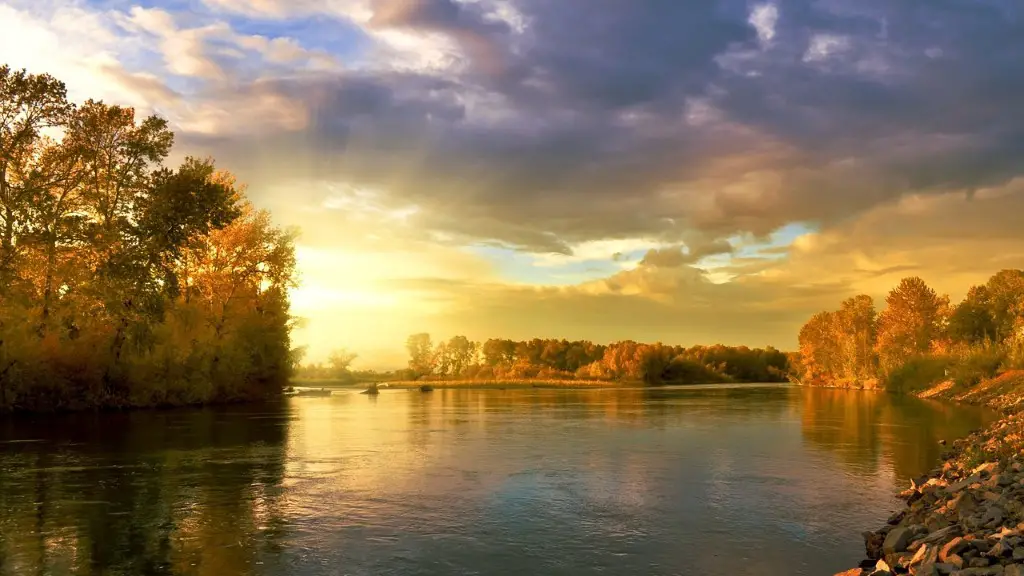The History of Floods along the Mississippi River
The Mississippi River is one of the most iconic waterways in the United States. From its origin in the northeastern corner of Minnesota, it travels clear across the country and through the city of New Orleans before emptying into the Gulf of Mexico. Over the centuries, it has been the lifeblood of the nation’s growing economy, providing fertile flooding plains for agricultural production and transport for goods from the Great Lakes to the Gulf Coast. The river has also been the source of a large part of the country’s population growth, providing a connection between the upper Midwest and the Gulf Coast for settlers who needed to get to the Deep South. The river has had to contend with a few natural disasters over its history, however, including flooding.
Floods along the Mississippi River have been a major problem since the 1800s. The great Mississippi River flooding in 1927 was the most destructive in history, affecting an area more than 27,000 square miles, including much of Arkansas, Missouri, Mississippi, and parts of Tennessee, Kentucky, and Illinois. The waters rose over 22 feet in several places, killing over 500 people and leaving hundreds of thousands homeless. In 1965, the flooding of the Mississippi River created another major disaster, as another 21,000 square mile area was affected by the flooding. This time, the damage was estimated at $1 billion, with 2,000 people being injured and two people losing their lives in the process.
In recent years, the floodwaters of the Mississippi have been managed more efficiently, making them less devastating for communities in the affected area. The United States Army Corps of Engineers has instituted flood control measures such as levees, dams and sandbag barriers, which help reduce the size and scope of a flood event. These measures have been successful in reducing the impact of flood events along the Mississippi, but they have not been able to completely prevent them. In 2008, floodwaters rose to record levels in many parts of the Mississippi River Basin, resulting in over $1 billion in damages.
Experts agree that climate change has been a major factor in increasing the severity and frequency of flooding along the Mississippi River. As global temperatures continue to rise, it is expected that heavy storms, with more rainfall and larger floods will be more common in coming years. This will put more strain on existing levees and flood control mechanisms, making floods more difficult to control. It is also expected that flooding could become more frequent as well, with more frequent “100 year floods” occurring.
Both governments and citizens groups are trying to address the issue of flooding along the Mississippi River. Many local communities are now taking measures to better prepare for floods, such as early warning systems and evacuation plans. As well, the US Army Corps of Engineers has continued to build better and stronger levees to better protect communities along the river. Governments are also looking into ways to improve the evacuation process, such as the use of buses, boats, and helicopters to move people to safety during floods.
Ultimately, it is impossible to predict with any sort of accuracy how many times the Mississippi River will flood in the future. But it is clear that with climate change, these floods may become more frequent and more destructive as time goes on. It is up to both governments and concerned citizens to actively work towards reducing the impact of these floods, and protecting the communities along the river.
Environmental Impact of the Mississippi Floods
The floods that have come along the Mississippi River have had a significant impact on the environment of the river’s basin. This is especially true of the 1927 and 1965 floods, which were both brutal events that claimed property, crops, and lives. In 1995, the U.S. Geological Survey (USGS) examined the environmental impact of the Mississippi floods and found that the impacts were still felt in the region years later. They noted that flooding can impact fish spawning and migration, disrupt wildlife habitat, and erode river banks, leading to long-term changes in the habitats of animals, plants, and insects in the affected area.
The flooding of the Mississippi has also been linked to changes in the watersheds of communities along the river. With the frequent inundation of floodwaters, algae and other submerged aquatic plants have begun to die off, reducing the amount of oxygen released into the water and creating large dead zones. This has had a devastating impact on the fish and other aquatic species living in the river, as well as the people who rely on the river for their livelihood. As well, dams built on the river have caused increased sedimentation in the river, leading to the potential for severe flooding downstream.
The floods of the Mississippi have also caused soil erosion in the region, with the USGS noting that the banks of the river can erode up to 20 feet a year. This sediment is then deposited in new areas, which can lead to unanticipated flooding downstream. This can be especially harmful to farmers, who can lose huge amounts of valuable topsoil to the floodwaters, as well as destroy their crops.
Ultimately, the floods of the Mississippi are having a major impact on the environment of the region. The waters of the river have become more unpredictable and can have serious consequences for both people and the ecosystem of the river in the long term. Governments and citizens alike must do their part in protecting the precious natural resources of the region, and ensuring the long-term health of the Mississippi.
The Economic Impact of the Mississippi Floods
Since the 19th century, flooding along the banks of the Mississippi River has had a significant impact on the economy of the region. For centuries, the floods have provided a vital source of income for farmers of the river’s drainage basin, as the flooding waters bring with them valuable nutrients from upstream. This has resulted in the area becoming one of the most important agricultural centres in the United States. The floods, however, have also caused economic losses for the region, with some of the most devastating floods leading to millions of dollars’ worth of damage.
The 1927 flood of the Mississippi was one of the worst in the region’s history, with damages estimated at more than $400 million. This was the equivalent of approximately $6 billion in today’s money. Most of the damage was due to the flooding of agricultural lands, along with the destruction of homes, businesses, and industrial facilities. These losses resulted in many of the area’s businesses closing, while some of its largest cities, such as St Louis, saw a dramatic decrease in their populations as people fled the area.
In recent years, the economic impact of the Mississippi’s floods has been reduced, due to improved levee and flood control systems along the river. The floods still cause losses, however, with the 2008 floodwaters causing over $2 billion in damages. This has led to a reduction in the amount of agricultural land available for planting, leading to a decrease in the amount of food and other products produced in the region. It has also caused a decrease in the number of jobs available in the region, resulting in a loss of income for many of its residents.
The floods of the Mississippi have had both positive and negative impacts on the economy of the region. The floods have provided a valuable source of nutrients to the soils of the Mississippi River basin, allowing farmers to produce some of the country’s most important crops. However, these floods have also led to losses in crops, homes, and businesses, and can have a long-term sting on local economies.
Managing the Floods Along the Mississippi
For centuries, people have been trying to manage the floods of the Mississippi River. Since the 1800s, governments have developed flood control systems, such as levees and sandbag barriers, which have helped to reduce the impact of flood events along the river. The U.S. Army Corps of Engineers has also been a key player, building levees and other flood control mechanisms in order to protect communities along the river. In recent years, these measures have been successful in containing the floods, but they cannot completely prevent them from happening.
The floods of the Mississippi have also been managed by local communities, which have taken measures to prepare for future flood events. In many of the affected areas, early warning systems and evacuation plans have been developed in order to minimize the impact of floods. In addition, the use of buses, boats, and helicopters has become more common in the evacuation process, allowing more people to be moved to safety quickly during a flood.
Finally, the government has taken steps to improve the flood control mechanisms along the river by introducing new technologies such as sensor networks and computer simulations. This has resulted in more efficient tools to manage the flooding of the Mississippi, allowing better predictions to be made and resources to be deployed when needed. These measures have been successful in reducing the impact of floods along the Mississippi, but they cannot completely prevent them.
The Effects of Deforestation on the Mississippi Floods
Deforestation has always been a concern for those managing the floods of the Mississippi River. For centuries, forests along the river’s banks have been home to a wide variety of wildlife and plants, providing food and refuge to the area. These forests, along with the wetlands and grasslands of the region, help to absorb the impact of floods, reducing the severity of flooding events along the river. Unfortunately, deforestation has destroyed much of the region’s vegetation, resulting in an increased risk of flooding in the area.
In recent years, the rate at which forests have been destroyed has increased dramatically, with an estimated 10 million acres of trees lost each year. This has had a devastating effect on the area’s natural landscape, leading to more exposed soil, which can be easily eroded by the floodwaters.
In addition, the loss of vegetation along the banks of the river has made it more difficult for the floodwaters to be absorbed, resulting in more water staying on the surface and posing a greater risk to the area.
Ultimately, the loss of vegetation in the Mississippi River basin has had a significant impact on the floods that have come along the river. The deforestation has made it more difficult to control the floods, as more exposed soil and less vegetation results in more water staying on the surface. It is up to both governments and citizens alike to take measures in order to protect the remaining vegetation of the region, in order to reduce the impact of floods along the Mississippi.
Conclusion and Recommendations
Floods along the Mississippi River have been a major problem since the 1800s, resulting in both economic and environmental losses in the region. These floods have been made worse by climate change, and are expected to become more frequent and more destructive in coming years. As such, it is up to both governments and citizens to take measures to reduce the impact of floods, such as early warning systems and evacuation plans. As well, important steps need to be taken in order to protect the vegetation of the region, as deforestation has been linked to an increased risk of flooding. By taking these steps, it is hoped that the future floods of the Mississippi can be managed more successfully, reducing the economic and environmental impact of these powerful river floods.





